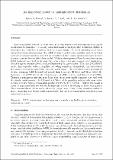An improved model for multiple effect distillation
Author(s)
Mistry, Karan Hemant; Antar, Mohamed Abdelkerim; Lienhard, John H.
DownloadMED-paper.pdf (432.1Kb)
OPEN_ACCESS_POLICY
Open Access Policy
Creative Commons Attribution-Noncommercial-Share Alike
Terms of use
Metadata
Show full item recordAbstract
Increasing global demand for fresh water is driving research and development of advanced desalination technologies. As a result, a detailed model of multiple effect distillation (MED) is developed that is flexible, simple to implement, and suitable for use in optimization of water and power cogeneration systems. The MED system is modeled in a modular method in which each of the subcomponents is modeled individually and then instantiated as necessary in order to piece together the complete plant model. Modular development allows for studying various MED configurations (such as forward feed, parallel feed, etc.) with minimal code duplication. Use of equation-oriented solvers, such as Engineering Equation Solver and JACOBIAN, rather than sequential solvers, simplifies the coding complexity dramatically and also reduces the number of required approximations and assumptions. The developed model is compared with four prominent forward feed MED models from literature. Through parametric analysis, it is found that the present model compares very well with the simple model provided by El-Sayed and Silver while providing substantially more detail in regard to the various temperature profiles within the MED system. Further, the model is easier to implement than the detailed El-Dessouky model while relying on fewer assumptions. The increased detail of the model allows for proper sensitivities to key variables related to input, operating, and design conditions necessary for use in a cogeneration or hybrid system optimization process.
Date issued
2012-07Department
Massachusetts Institute of Technology. Department of Mechanical EngineeringJournal
Desalination and Water Treatment
Publisher
Desalination Publications
Citation
Mistry, Karan H., Mohamed A. Antar, and John H. Lienhard V. “An Improved Model for Multiple Effect Distillation.” Desalination and Water Treatment 51, no. 4–6 (January 2013): 807–821.
Version: Author's final manuscript
ISSN
1944-3994
1944-3986